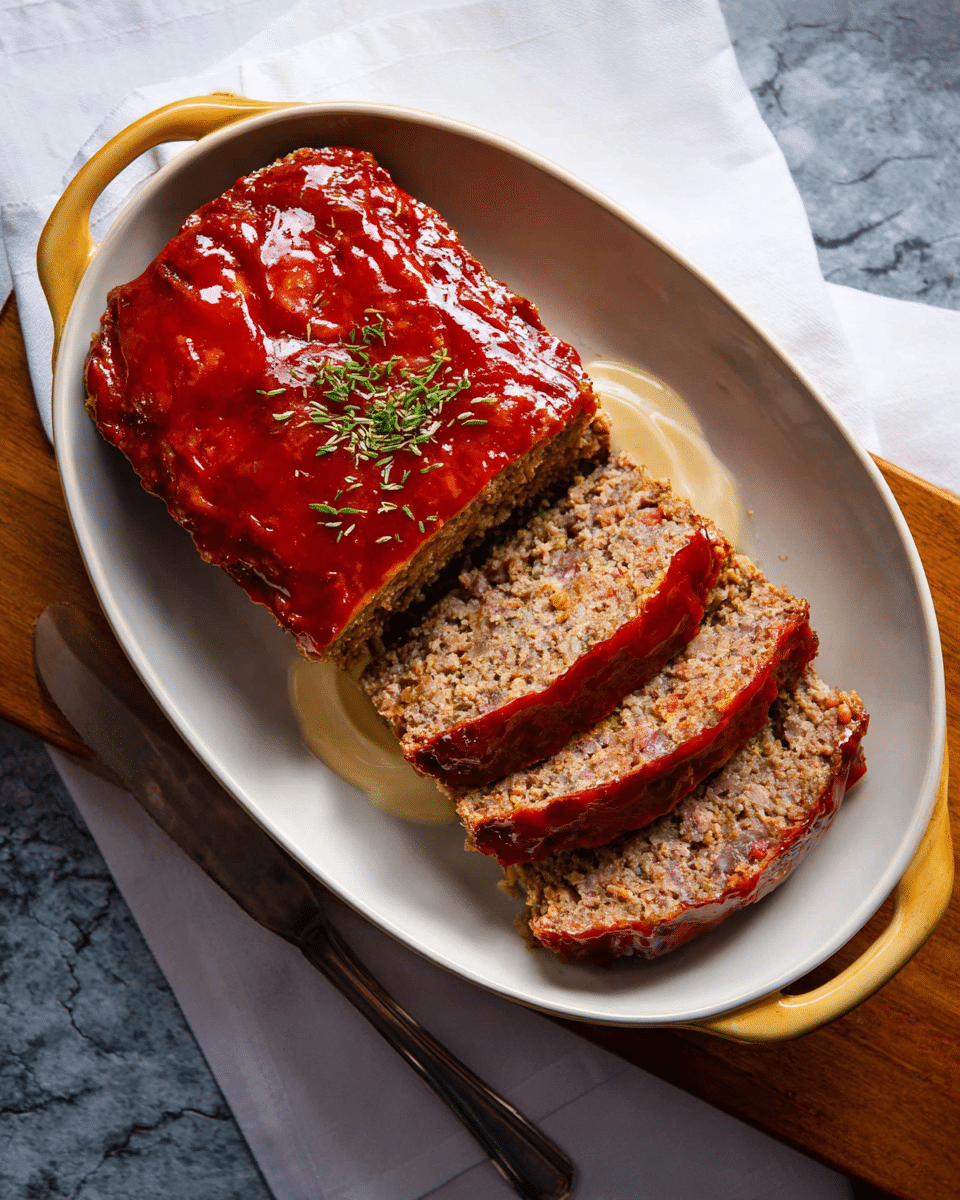The ultimate comfort dish, this Classic Meatloaf brings together juicy ground beef, savory aromatics, and a sweet-tangy glaze baked to perfection. It’s a nostalgic nod to traditional American cooking—simple ingredients, bold flavors, and a dish that fills both belly and heart.
Whether you’re feeding a hungry family or looking for a satisfying meal prep solution, this meatloaf delivers. It pairs beautifully with mashed potatoes, steamed green beans, or even a crisp salad. With a perfectly caramelized glaze on top, it’s sure to become a staple in your kitchen.
Full Recipe
Ingredients:
-
2 lbs ground beef (80/20)
-
1 cup breadcrumbs
-
1 onion, finely chopped
-
2 cloves garlic, minced
-
1/2 cup milk
-
2 large eggs
-
1/4 cup ketchup (for meatloaf)
-
2 tbsp Worcestershire sauce
-
1 tsp salt
-
1/2 tsp black pepper
For the Glaze:
-
1/2 cup ketchup
-
2 tbsp brown sugar
-
1 tbsp apple cider vinegar
Directions:
-
Preheat your oven to 350°F (175°C).
-
In a large mixing bowl, combine ground beef, breadcrumbs, onion, garlic, milk, eggs, ketchup, Worcestershire sauce, salt, and pepper. Mix until just combined—don’t overwork it.
-
Transfer the meat mixture to a lined or greased baking sheet and shape it into a loaf about 9×5 inches.
-
In a small bowl, whisk together the glaze ingredients: ketchup, brown sugar, and apple cider vinegar.
-
Spoon half of the glaze over the top of the meatloaf before baking.
-
Bake uncovered for 55–60 minutes, or until internal temperature reaches 160°F (71°C).
-
In the last 10 minutes of baking, spread the remaining glaze on top.
-
Let it rest for 10 minutes before slicing and serving.
Prep Time: 15 minutes | Cooking Time: 60 minutes | Total Time: 1 hour 15 minutes
Kcal: 340 kcal | Servings: 6 servings
The Timeless Appeal of Classic Meatloaf
Few dishes capture the essence of homestyle American comfort food quite like classic meatloaf. It’s a dish that has stood the test of time, gracing dinner tables across generations with its savory aroma, hearty texture, and unmistakable flavor. While many meals fall in and out of popularity, meatloaf remains a beloved staple—and for good reason. It’s affordable, adaptable, and incredibly satisfying.
Though modern food culture is often focused on trends, meatloaf reminds us of something more important: simplicity done right. Its familiar taste brings nostalgia and warmth, evoking memories of family dinners, cozy kitchens, and handwritten recipes passed down from one generation to the next.
A Brief History of Meatloaf
The origins of meatloaf can be traced back centuries, long before it became a household name in North America. Variations of minced meat dishes were found in ancient Rome, where seasoned ground meat was formed into loaves and baked. In 18th and 19th century Europe, particularly Germany and Scandinavia, ground meat mixtures formed the basis of many economical family meals. These early versions often included a mixture of meats, grains, and vegetables.
The American version of meatloaf started taking shape during the Great Depression. It became a practical solution to feed large families on a tight budget. Housewives stretched meat by adding fillers like breadcrumbs, oats, or even crushed crackers. The ketchup-based glaze—now a hallmark of the dish—was an innovation that brought both sweetness and moisture to the recipe, making it even more appealing.
Why Meatloaf Is Still Loved Today
Meatloaf has earned a permanent spot in culinary tradition because of its affordability, versatility, and sheer comfort factor. It’s one of those rare meals that works equally well for a busy weeknight or a cozy Sunday dinner. It can be prepped ahead of time, stored easily, and reheated without losing quality.
Beyond practicality, meatloaf speaks to something deeper: the joy of homemade food. In a world where fast food and takeout dominate, making a meatloaf from scratch is a small rebellion—a declaration that cooking for oneself or one’s family still matters.
Secrets to a Moist and Flavorful Meatloaf
Though meatloaf is a humble dish, making it exceptionally good requires a few important techniques. The first is balance: you want the right ratio of meat to binder and liquid. Too much meat without enough filler or moisture will make your loaf dense and dry. Breadcrumbs soaked in milk help retain juiciness, while eggs provide structure.
Next, seasoning is key. Onion and garlic should be finely chopped or even sautéed beforehand to mellow their bite and integrate fully into the mix. Worcestershire sauce and ketchup offer rich umami and tang, which bring depth to every bite.
Another trick? Don’t overmix. Once your ingredients are combined, mix them just until they hold together. Overworking the mixture can make the meat tough.
Finally, shaping the loaf on a baking sheet rather than using a loaf pan allows fat to drain away and creates those delicious crusty edges that everyone loves.
The Signature Glaze: More Than Just Ketchup
One of the most distinctive features of a classic meatloaf is its glossy, sweet-savory glaze. While some purists may opt for plain ketchup, the magic lies in combining it with brown sugar and a touch of vinegar. This blend caramelizes beautifully during baking, creating a sticky coating that enhances both texture and taste.
The glaze is often applied twice—once before baking and once near the end—to ensure it builds flavor and sheen without burning. You can even experiment with add-ins like mustard, hot sauce, or BBQ sauce for a personalized twist.
Popular Variations of the Classic Recipe
Though the basic formula remains consistent, meatloaf is incredibly adaptable. Here are a few ways people customize it across different households and cultures:
-
Meat Blends: Mixing ground beef with pork or veal can enhance flavor and tenderness.
-
Vegetable Additions: Chopped mushrooms, grated carrots, or even spinach can be added for extra nutrition and moisture.
-
Spice Infusions: For a global twist, some cooks add taco seasoning, curry spices, or Italian herbs.
-
Toppings and Fillings: Some recipes include cheese layers, hard-boiled eggs, or bacon strips on top for extra indulgence.
Vegetarians and vegans also enjoy meatloaf in their own way by replacing meat with lentils, beans, nuts, or plant-based crumbles. These variations often use flaxseed or aquafaba as binders and creative spices to mimic the comforting essence of the original.
Perfect Pairings and Serving Ideas
A classic meatloaf calls for equally comforting side dishes. Mashed potatoes are the obvious—and delicious—choice. Their creamy texture pairs beautifully with the meatloaf’s savory heft. Roasted vegetables like carrots, green beans, or Brussels sprouts add freshness and color to the plate.
Some families serve it with mac and cheese for a truly indulgent meal, while others prefer a side of buttered corn or a simple garden salad to lighten things up.
Leftovers are another advantage. Meatloaf makes excellent sandwiches—served cold or reheated between two slices of toasted bread with a little extra ketchup or mayo. You can also crumble leftover meatloaf into pasta dishes or grain bowls.
Why It’s Great for Meal Prep
Meal prepping has become essential for busy households, and meatloaf is a natural fit. It stores well in the fridge for 3–4 days and can be frozen either whole or in individual slices. When properly wrapped, it retains moisture and flavor even after reheating.
You can also prepare the meatloaf mixture in advance and refrigerate it raw, then bake it fresh when needed. Some even prefer baking it ahead and slicing cold for easy portioning throughout the week.
Meatloaf Across Generations
There’s something beautifully timeless about the act of serving meatloaf. Whether it’s your grandmother’s handwritten recipe card or a newer twist discovered online, it’s the kind of dish that creates tradition. It’s passed down not because it’s flashy, but because it’s reliable—because it brings people together around the table.
Many families have their own sacred version of the recipe, with debates about whether ketchup or barbecue sauce belongs on top, whether to bake in a loaf pan or free-form, or whether oats or breadcrumbs make the better binder. These small differences are part of what makes it so special.
Conclusion: A Dish Worth Revisiting
In today’s fast-paced, hyper-innovative food culture, classic meatloaf remains a grounded, dependable favorite. It’s more than just a recipe—it’s a story of resourcefulness, love, and home. Each slice represents the hands that made it, the hunger it satisfied, and the comfort it delivered.
Whether you’re cooking for one, feeding a family, or simply trying to reconnect with something nostalgic, classic meatloaf is always a good idea. It’s familiar, affordable, and endlessly customizable, proving that great food doesn’t need to be complicated. All it needs is care.
So the next time you’re wondering what to make for dinner, consider this humble masterpiece. Let it remind you why you fell in love with cooking in the first place.






